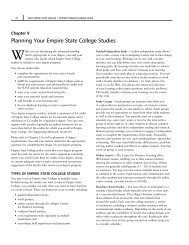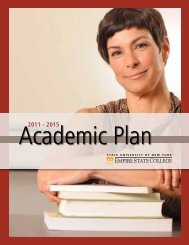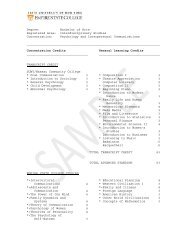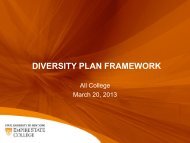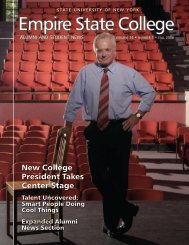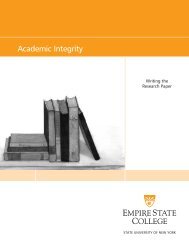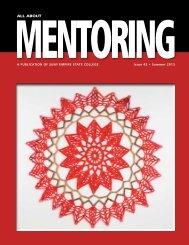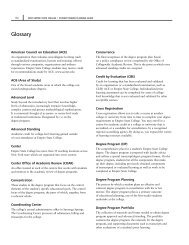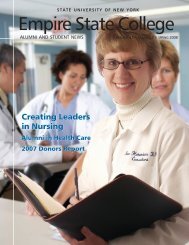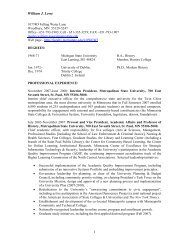All About Mentoring Spring 2011 - SUNY Empire State College
All About Mentoring Spring 2011 - SUNY Empire State College
All About Mentoring Spring 2011 - SUNY Empire State College
You also want an ePaper? Increase the reach of your titles
YUMPU automatically turns print PDFs into web optimized ePapers that Google loves.
82<br />
sense, online learning itself is no longer<br />
an attractive niche either. There are giant<br />
companies like Blackboard providing<br />
learning management systems for large<br />
numbers of schools serving all sorts of<br />
students, and the processes for offering<br />
online learning in this way are quite well<br />
developed, routine and affordable. If many<br />
schools are doing this right now, is there<br />
really anything innovative about <strong>Empire</strong><br />
<strong>State</strong> <strong>College</strong> doing it No, because we<br />
are simply sustaining what already exists.<br />
The key to success, then, would be to<br />
identify “new” groups of nontraditional<br />
students unlike the students other schools<br />
are recruiting, or just like those students<br />
but finding new ways to serve them. For<br />
example, one could look at international<br />
students who want American-style<br />
educations but are not living in places<br />
with significant competition. The college<br />
could leverage its skills providing online<br />
and blended models to these “less<br />
attractive” markets through a new unit<br />
devoted to trying new tools for teaching<br />
or ways of teaching.<br />
There are large populations of immigrants,<br />
many or most not native speakers of<br />
English: they need help succeeding in college<br />
and could become a large market over time.<br />
A program that developed enhanced literacy<br />
skills in English or provided non-English<br />
language education as a prerequisite or a<br />
co-requisite along with college-level learning<br />
might open up new educational possibilities<br />
for an institution that wanted to develop the<br />
resources, the structures and the processes<br />
relevant to that new student body.<br />
Educational technology used in new<br />
and different ways might work well.<br />
Smart phones are one arena for growth<br />
possibilities, but they may not be the only<br />
one. I have no doubt that other technologies<br />
or ways to use these new “learning<br />
platforms” will develop quickly.<br />
As I pointed out earlier, throughout their<br />
work, Christensen and his co-authors<br />
observe that the “profit margins” here may<br />
be smaller than in the “upmarket” services,<br />
but they can grow to be very large over<br />
time. They also point out that there is no<br />
incentive to try these new approaches on<br />
the part of senior management (or members<br />
of the organization) devoted to sustaining<br />
existing services. But, a group of faculty and<br />
staff who could think creatively about these<br />
opportunities, in an autonomous unit with<br />
a different organizational design, could well<br />
balance its budget quickly and grow fast<br />
enough down the road to create a thriving<br />
new niche that would serve the college well<br />
in the coming decades.<br />
Interestingly, from Christensen’s point of<br />
view, these new tools and approaches do<br />
not need to be as good as the existing ones;<br />
and, they do not need to succeed all the<br />
time. They only have to be good enough and<br />
offer something new to people who are not<br />
using the services now. However – and this<br />
is a crucial point for us – from a Christensen<br />
point of view, they cannot be integrated into<br />
the existing organizational culture; in such a<br />
context, evidence suggests they will fail.<br />
In one sense, students are not like<br />
transistors, but Christensen and his<br />
co-authors do note that the same<br />
organizational and market imperatives do<br />
exist across a wide range of products and<br />
services. <strong>Empire</strong> <strong>State</strong> <strong>College</strong> has benefited<br />
from disruption in the past and has led a<br />
lot of it. But, yesterday’s disruptions are<br />
today’s sustaining approaches. Today’s and<br />
tomorrow’s disruptions mean growth and<br />
success in the future. The organizational<br />
questions at <strong>Empire</strong> <strong>State</strong> <strong>College</strong> and at<br />
other schools are these: What is the new<br />
disruption How could/would/should we<br />
organize to create disruptions – whether<br />
of structure, of technology or of values, or<br />
respond to disruptions when they occur<br />
I intend this essay to begin a discussion<br />
about directions. I fully expect that many<br />
readers will disagree vigorously with<br />
some of my assumptions and many of my<br />
conclusions, or with the premises upon<br />
which Christensen has built his argument.<br />
Still, I trust that, in a spirit of open debate<br />
(in the spirit of disruption!), our colleagues’<br />
observations and analyses will help spur the<br />
college to be even more successful in the<br />
future than it has been in the past.<br />
Notes<br />
1<br />
The author used Kindle format versions<br />
of Christensen’s work. As such,<br />
citations refer to the locations in the<br />
Kindle version.<br />
2<br />
I can attest from personal experience<br />
to the risks organizational culture can<br />
create in this context. For 16 years,<br />
I taught and mentored in a program<br />
similar to <strong>Empire</strong> <strong>State</strong> <strong>College</strong>,<br />
Skidmore <strong>College</strong>’s University Without<br />
Walls (UWW). Although my former<br />
program was located in a separate unit<br />
at its college, it was frequently starved<br />
for resources by the larger organization,<br />
was constantly seen as an outlier in the<br />
organizational culture, and eventually<br />
was killed off by the administration.<br />
UWW officially closed its doors in<br />
May <strong>2011</strong>.<br />
suny empire state college • all about mentoring • issue 39 • spring <strong>2011</strong>




